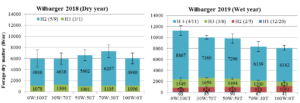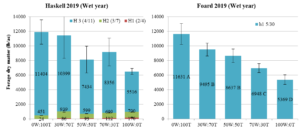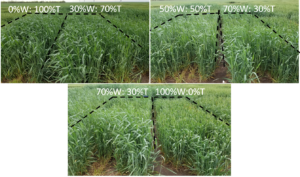Emi Kimura, Extension Agronomist, Vernon, TX
UNIFORM FORAGE TRIAL
Uniform Forage trial was conducted at Lockett, TX. Plots were planted at 90 lbs/ac seeding rate on Miles fine sandy loam on 2 October 2019. Total precipitation received during October 2018 to May 2019 was 15.8 inch. Forage was clipped one time on 31 May 2019. The highest forage yield among released variety (species) was SlickTrit II (triticale), followed by CP7869 (wheat), WB4515 (wheat), and CP7909 (wheat).
Table 1. 2019 Uniform Forage Trial at Lockett, TX.
Background information: Seeding rate (90 lb/ac), Planting (10/2/2019), and Clipping (5/31/2019).
aVarieties ranked according to 2019 yield averages. cHighlighted values are statistically same as the highest value.
Statewide forage variety trial will be available at http://varietytesting.tamu.edu/wheat/.
TRITICALE WHEAT MIXTURE TRIAL
Triticale is getting popular in the Rolling Plains for their high forage yield potential. Triticale with a full maturity characteristic can produce forage yield until early summer in the Rolling Plains; however, producers are looking for species/varieties that can produce early fall forage in addition to the early summer forage to extend grazing period.
The study was conducted at Wilbarger County in 2017-2018 year (dry year) and at Foard, Haskell, and Wilbarger County during 2018-2019 year (wet year). Awnless variety of wheat (W) (TAM 401, early maturity) and awnless variety of triticale (T) (SY Trit 348, full maturity) were planted at five ratios at 0W:100T (100% triticale), 30W:70T, 50W:50T, 70W:30T, and 100W:0T (100% wheat). We used seeding rate of 90 lb/ac. For example for 50W:50T treatment, wheat seeds at 45lb/ac and triticale seeds at 45 lb/ac were mixed thoroughly and planted into plots.
Table 2. Background information of the trials
| 2017-2018 | 2018-2019 | 2018-2019 | 2018-2019 | |
| Wilbarger | Foard | Haskell | Wilbarger | |
| Planting | 10/17/2017 | 11/9/2018 | 10/4/2018 | 10/3/2018 |
| Clipping 1 | 3/1/2018 | 5/30/2019 | 2/4/2019 | 2/5/2019 |
| Clipping 2 | 5/10/2018 | – | 3/7/2019 | 3/6/2019 |
| Clipping 3 | – | – | 4/11/2019 | 4/11/2019 |
| N application | 100# N after 1st clip | 50# N in Feb. | 100# N after 1st clip | 100# N after nd clip |
| Oct-May precipitation | 4.3 (Drought Year) | 15.8 | 29.8 | 15.8 |
Results and Discussions
Despite mixing the early maturity wheat variety, the early fall forage was not available. The earliest clipping was conducted on December 20th in 2019; however, the yield was low (range: 41 to 95 lb/ac) (Figure 1). We will include other species such as oat or barley in the mixtures and examine whether they would produce early fall forage in 2019-2020 cropping year.
In 2018 (dry year), total forage yields among all treatments were similar, indicating that there was no yield advantage of triticale in the mixtures in the dry year. In 2019 (wet year), total forage yield was higher in the plots with higher triticale ratio (Figure 1). This indicates that triticale would increase total forage yield if there is enough soil moisture.
Figure 1. Forage dry matter (lb/ac) of triticale wheat mixture trials in Wilbarger County in 2018 and 2019.
The similar results were observed in Haskell and Foard County trials in 2019. Total forage yield was higher at higher triticale ratios in 2019 (Figure 2). The mixture between triticale and wheat can improve total forage dry matter and provide livestock with varying forage quality (Figure 3). The photo taken on 17 April 2019 shows pre-boot stage of triticale with high amount of leafy materials as compared to wheat at fully headed maturity.
Figure 2. Forage dry matter (lb/ac) of triticale wheat mixture trials in Haskell and Foard County in 2019.
Figure 3. Photos taken on April 17, 2019 at Haskell County trial site. Maturity stage of triticale was before boot stage with good amount of leafy materials, while TAM401 was at heading.
Summary of the trial will be available at https://agrilife.org/txrollingplainsagronomy/range-and-pasture/ under “Triticale Wheat Mixture Trial”.


